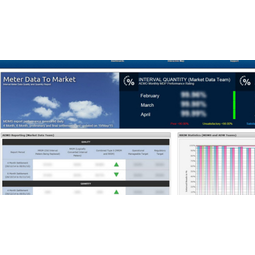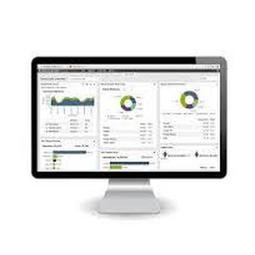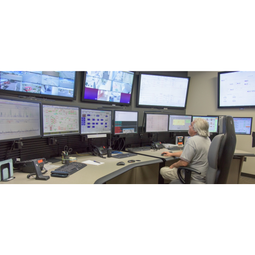Overview
 |
Advanced Metering Infrastructure |
Applicable Industries
Applicable Functions
Case Studies
Market Size
|
The advanced metering infrastructure (AMI) market is expected to grow from USD 4.48 billion in 2015 to USD 9.19 billion in 2020, at a Compound Annual Growth Rate (CAGR) of 15.5%. The smart meters market is expected to grow from an estimated USD 12.79 billion in 2017 to USD 19.98 billion by 2022, registering a CAGR of 9.34% from 2017 to 2022. Source: Markets and Markets The outage management system market is expected to grow from an estimated USD 0.4 billion in 2016 to USD 1.48 billion by 2021, at a CAGR of 18.4%. Source: Markets & Markets The global smart electricity meter market size was estimated at USD 29.58 billion in 2016 and is expected to grow at 5.9% CAGR between 2018 and 2025. Source: Grand View Research |
Business Viewpoint
|
How does advanced metering infrastructure (AMI) impact an organization’s performance? For governments and utilities that deploy AMI systems, the main value is derived from four functionalities. First, AMI enables the automation of scheduled readings without dispatching personnel to meters. This is a labor intensive and costly job that can be completely automated. Secondly, operators can remotely switch meters on or off at a very granular level in real time. Thirdly, data collection enables operators to better understand user behavior and to optimize efficiency across the grid. And finally, firmware can be upgraded over the air, enabling continuous improvement through software upgrades at a low cost. For end users (both citizens and businesses), the value is primarily generated from the ability to collect real-time data regarding energy consumption trends to improve efficiency. During peak hours, messages can also be sent to end users to request that they constrain usage for a period of time in return for an immediate monetary benefit. Users can plan high-energy consumption activities, such as running the dishwasher, during off-peak hours to lower their energy bills. Access to data for end users is referred to as "route B" and is not always provided because end users do not always have a justifiable ROI on the infrastructure required to provide them with access to data. The monitoring of electric power helps to identify important power quality problems such as voltage sags and swells, interruptions, harmonics, and high-frequency noise, consistently seen in industrial and commercial grid applications. Troubleshooting these problems requires accurate measurements and analysis of power quality with monitoring instruments that can effectively locate issues and identify solutions. How is the performance of an AMI system measured? The most common measurement is the percent of total readings that are 'reliable' (both accurate and on time). If the proportion of reliable readings fall below a specified threshold the system operator or provider may be fined. However, the reliability of data can be difficult to quantify. What are the typical capabilities of an AMI system? AMI systems enable two-way communication between utilities and customers. They provide an array of functions such as remotely measuring electricity use, connecting and disconnecting services, and monitoring voltage. If AMI is used with consumer technologies, it may also enable utilities to offer new time-based rate programs that encourage consumers to reduce energy consumption and energy bills. A common capability is peak demand metering. An electric demand meter works on the principle that customers who require a higher or more intensive level of service during bursts of peak demand should pay more for the availability of that service. Electricity flows in a current. It cannot be stored. It's not possible to cut back on electricity four or five days in advance to have power on reserve for peak demand. A demand meter calculates billing based on the highest level of service that a residential or commercial customer would possibly need. With electric service, a family or business that places demands on the electric grid, for example, to run an energy-intensive mainframe computer, would require more capacity from the electricity grid during those periods of peak demand than would a household or business that did not have such energy-demanding equipment. Even businesses or homes that used more electricity overall wouldn't place the same kind of demand on the electric grid, because most electricity systems are capable of handling a normal demand load from their customers.
|
Stakeholder Viewpoint
|
Which organizations, departments or individuals typically make investment decisions and allocate budgets for advanced metering infrastructure (AMI) systems? AMI deployments are typically large, expensive, and impactful for many stakeholders. As a result, multiple departments are typically involved in the decision process. It is common for portions of a project to be decided by different departments (for example the IT department may select the software system, while operations will determine the hardware). In smaller deployments, city governments may outsource projects to system integrators who would run the request for proposal process and manage integration on the city's behalf. In these cases, technology selection decisions are often driven by existing relationships that the system integrator has with technology partners. Which organizations, departments, or individuals are responsible for operating and maintaining AMI systems? As with technology selection, different departments are often responsible for operations and maintenance of the hardware, software, and connectivity components of a system. Who are the regular users of AMI systems? Depending on the application, who the user is may vary. Typically from a utility standpoint, the regular users of AMI would be employees of the utility company or government agency that operates the infrastructure. Utilities may provide system access to technologies to enable devices such as in-home displays and programmable thermostats, these businesses to become users of the AMI system. Manufacturers and other industrial end users are also increasingly active to deploy AMI systems or work with their utility to gain access to AMI data in order to optimize their energy usage. Which external stakeholders would benefit most from AMI data? Data is typically not be shared with external stakeholders due to privacy concerns. However, a number of startups and investors have sought to create marketplaces based on utility or individual facility data as a leading indicator of energy price trends. This data, if accurate and timely, could be useful in making investment decisions.
|
Technology Viewpoint
|
Where is the “edge” of the advanced metering infrastructure (AMI) system deployed? The edge of an AMI system is defined by the deployment of sensors. Sensors can be deployed on individual machines in a factory, at meters measuring electricity into individual apartments, or at centralized meters on buildings. As the "edge" moves closer to the actual use of the measured commodity, the granularity of the data improves but so does the cost of deployment and operations. What sensors are typically used to provide AMI data into the IoT system, and which factors define their deployment? There are many global smart meter manufacturers and their technology is typically similar in functionality. However, quality can be a significant issue. In many cases, the use of low-quality sensors has resulted in the failure of a system due to a high proportion of malfunctioning sensors. Sensors are often placed in high-stress environments, where they are must operate over the lifecycle of the system under extreme temperatures. What systems commonly use the data provided by an AMI system? An Outage Management System (OMS) is a computer system used by operators of electric distribution systems to assist in the restoration of power. At the core of a modern outage management system is a detailed network model of the distribution system. The utilities Geographic Information System (GIS) is usually the source of this network model. By combining the locations of outage data from sensors, a rules engine is used to predict the locations of outages. Because the distribution system is tree-like or radial in design, all sensor inputs in a region downstream from a fuse could be inferred to be caused by a single fuse or circuit breaker upstream of the sensors. Outage data have been traditionally input by call takers in a call center utilizing a customer information system (CIS). However, this process can not be automated to improve efficiency and reaction time by accessing data from all sensors on the network at regular intervals, rather than data from individual people at random intervals. What factors define the connectivity solutions used to provide both device-to-device and device-to-cloud communication? Connectivity technologies such as Weightless are critical to enabling AMI solutions. The primary bottleneck is moving the data, not collecting the data. Review of wireless technologies is rigorous. Key variables include: 1. Reliability of wireless data transmission - how much data was sent reliably over a specific time period. 2. Total infrastructure cost - one bay station could be able to collect to 10x more units than another technology. Mesh communication shows promise but at present that distance that data can be reliably transmitted is too short to enable competitive infrastructure setup.
|
Data Viewpoint
|
How is data obtained by advanced metering infrastructure (AMI) systems? AMI data comes from sensors that are installed on meters. Sensors can be connected by ethernet or wireless transceivers. They can also be powered by cable or battery. In regards to energy and connectivity, wired sensors are more stable and have lower operating costs. However, wiring can require a significant infrastructure investment. This is particularly true in remote regions where meter endpoints are not yet wired. As a result, wired sensors are most common when deployed on meters in buildings or other infrastructure with available power sources. Wireless sensors provide flexibility and can be deployed on unconnected endpoints. Advances in battery technology, low power protocols, and mesh networking are making wireless sensors increasingly practical. What data points are typically collected by the system? AMI systems can be used to measure electricity, liquid fuels, gases, water and the flow of other commodities. Data collection develops on the underlying commodity. However, across systems, common measurements include the rate of consumption, utility infrastructure usage, and the proportion of usage by specific equipment (such as air conditioners, lighting, or a specific machine). AMI data points are collected to offer time-based rates or incentives. The aim of utilizing this data and offering incentives is to reduce peak demand and lower costs. What volume of data is expected from an AMI deployment? The scale of an AMI deployment can range from an individual factor to a regional utility. A small deployment on a factory may include several hundred to several thousand sensors. A large deployment at a utility may include several million meters. A typical meter may send 20-40 bytes of data every 15 minutes continuously. However, the rate of data transmission can be reduced or increased significantly depending on the specific use case and the value of real-time data. The key IT challenge is not managing data volume but managing the consistency of data transmissions. What other requirements define AMI data behavior? Communications networks and systems must deliver accurate and reliable streams of data in a timely manner. These networks connect smart meters to head-end systems which manage data between smart meters and other information systems including MDMS, CIS, OMS, and DMS. Low power, wide area networks, 5G, mesh networking, and other technologies hold promise to lower the cost and improve the reliability of AMI systems Integration with data management systems is also critical. Legacy information and management systems such as CIS, OMS, and DMS were often not designed to handle a large amount of data from meters. Therefore, the integration of information and management systems, and potentially system upgrades, is necessary when deployment an AMI system. |
Deployment Challenges
|
What business challenges could impact advanced metering infrastructure (AMI) system deployment? AMI systems typically have an extensive due diligence process lasting 12-18 months. Many departments are part of the decision process and they may have conflicting requirements or objectives. Each portion of the project could also be a procured through separate tender run by a different department. What factors impact the integration of this use case technologies into a cohesive system? System integration and deployment can be implemented by the connectivity provider, another technology provider, or a traditional contractor. Often the technology providers will support a contractor who will deploy teams on the ground. Whereas bay stations are more likely to be deployed by the connectivity providers. What regulatory challenges could impact AMI deployment? Regulations vary by region, and many utilities must abide by local, regional, and national regulations. The degree of difficulty in navigating regulatory barriers varies greatly by the nation but they are in all cases present.
|
Expert Contributors







